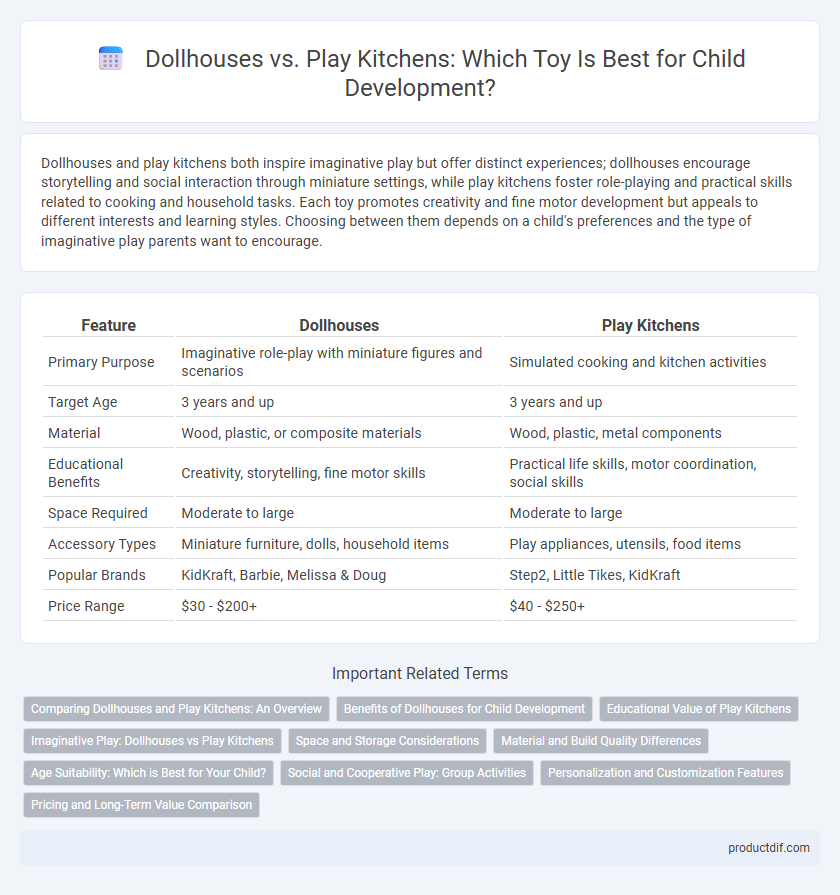Dollhouses and play kitchens both inspire imaginative play but offer distinct experiences; dollhouses encourage storytelling and social interaction through miniature settings, while play kitchens foster role-playing and practical skills related to cooking and household tasks. Each toy promotes creativity and fine motor development but appeals to different interests and learning styles. Choosing between them depends on a child's preferences and the type of imaginative play parents want to encourage.
Table of Comparison
| Feature | Dollhouses | Play Kitchens |
|---|---|---|
| Primary Purpose | Imaginative role-play with miniature figures and scenarios | Simulated cooking and kitchen activities |
| Target Age | 3 years and up | 3 years and up |
| Material | Wood, plastic, or composite materials | Wood, plastic, metal components |
| Educational Benefits | Creativity, storytelling, fine motor skills | Practical life skills, motor coordination, social skills |
| Space Required | Moderate to large | Moderate to large |
| Accessory Types | Miniature furniture, dolls, household items | Play appliances, utensils, food items |
| Popular Brands | KidKraft, Barbie, Melissa & Doug | Step2, Little Tikes, KidKraft |
| Price Range | $30 - $200+ | $40 - $250+ |
Comparing Dollhouses and Play Kitchens: An Overview
Dollhouses offer intricate miniature environments that stimulate imaginative storytelling and fine motor skills, while play kitchens encourage role-playing and basic cooking skills development through interactive appliances. Both toys support social interaction, but dollhouses often emphasize detailed decor and character-driven narratives, whereas play kitchens provide hands-on experiences with food preparation concepts. Choosing between them depends on whether a child prefers narrative creativity or practical life skill exploration.
Benefits of Dollhouses for Child Development
Dollhouses foster imaginative play, enhancing creativity and storytelling skills in children by allowing them to create and act out scenarios. They improve fine motor skills through the manipulation of miniature furniture and accessories. Social development is supported as kids often engage in cooperative play, practicing communication and empathy.
Educational Value of Play Kitchens
Play kitchens enhance children's cognitive development by encouraging role-playing, problem-solving, and basic math skills through activities like measuring and sorting. These toys promote social skills and creativity as kids simulate real-life scenarios, fostering communication and collaboration. Unlike dollhouses that primarily focus on imaginative storytelling, play kitchens offer practical life skills and hands-on learning experiences.
Imaginative Play: Dollhouses vs Play Kitchens
Dollhouses and play kitchens both foster imaginative play but engage children in different creative scenarios; dollhouses encourage storytelling and role-playing with miniature characters, while play kitchens simulate real-life cooking experiences that promote practical life skills. Studies show play kitchens enhance social interaction and cooperation as children mimic family roles, whereas dollhouses stimulate narrative development and fine motor skills through detailed manipulation of small accessories. Choosing between them depends on whether the goal is to inspire complex storytelling or hands-on, realistic pretend play.
Space and Storage Considerations
Dollhouses typically require more vertical space due to their multi-level design, making them ideal for rooms with high shelves or corners. Play kitchens often need a wider footprint but provide built-in storage compartments for toy utensils and food, maximizing organization and accessibility. Choosing between the two depends on available room dimensions and the importance of integrated storage for play accessories.
Material and Build Quality Differences
Dollhouses often feature intricate wooden or composite materials, providing sturdy construction that supports detailed craftsmanship and realistic designs. Play kitchens typically use durable plastic or laminated wood to withstand rough play and frequent cleaning, emphasizing functionality over intricate detail. The build quality in dollhouses prioritizes aesthetic authenticity, while play kitchens focus on resilience and ease of maintenance.
Age Suitability: Which is Best for Your Child?
Dollhouses are generally suitable for children aged 3 and up, promoting imaginative play and fine motor skills through detailed miniature furniture and figures. Play kitchens also target a similar age range but are often preferred for children aged 2 to 6, encouraging role-playing and social interaction with larger, more durable components. Choosing between dollhouses and play kitchens depends on your child's developmental stage and interests, with both offering unique benefits for cognitive and creative growth.
Social and Cooperative Play: Group Activities
Dollhouses foster social and cooperative play by encouraging children to create shared narratives and role-play family or community scenarios, enhancing communication skills and empathy. Play kitchens promote teamwork through collaborative cooking activities and problem-solving, helping kids work together while developing social bonds. Both toys support group interaction but dollhouses emphasize imaginative storytelling, whereas play kitchens focus on practical cooperation.
Personalization and Customization Features
Dollhouses offer extensive personalization options, including customizable furniture, wallpaper, and doll figurines that encourage imaginative play tailored to individual preferences. Play kitchens provide customization through modular components, interchangeable accessories, and appliance features that adapt to different play scenarios. Both toys enhance creativity by allowing children to design unique play environments that reflect their personal tastes and storytelling styles.
Pricing and Long-Term Value Comparison
Dollhouses typically range from $50 to $300 depending on the size and features, offering intricate design and imaginative play that can sustain interest over many years, making them a valuable investment for durability and creativity. Play kitchens generally cost between $40 and $250, providing interactive role-playing experiences that encourage social skills and can adapt to changing play preferences, contributing to lasting engagement. When comparing pricing and long-term value, dollhouses often offer higher upfront costs but greater longevity, while play kitchens balance affordability with versatile development benefits.
dollhouses vs play kitchens Infographic

 productdif.com
productdif.com